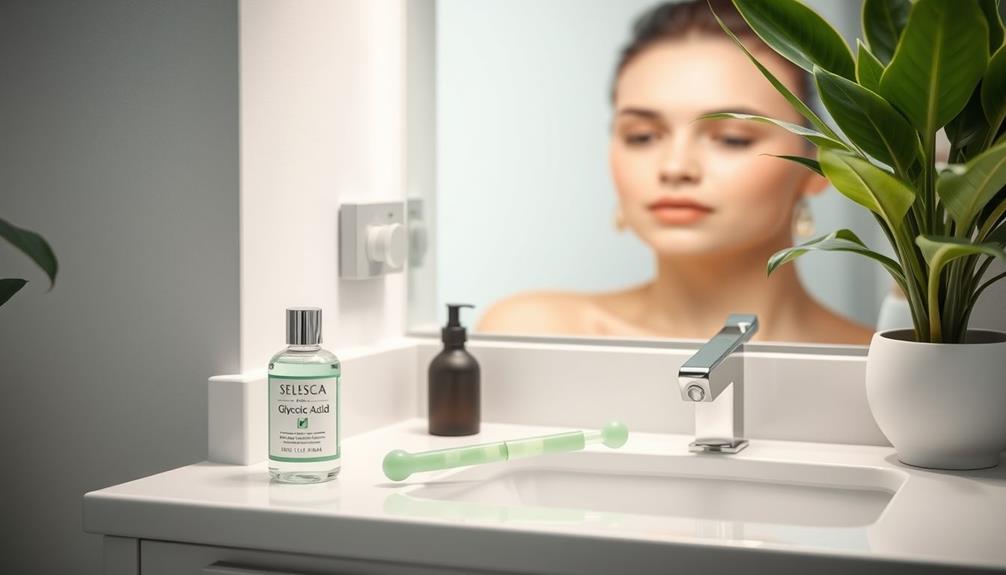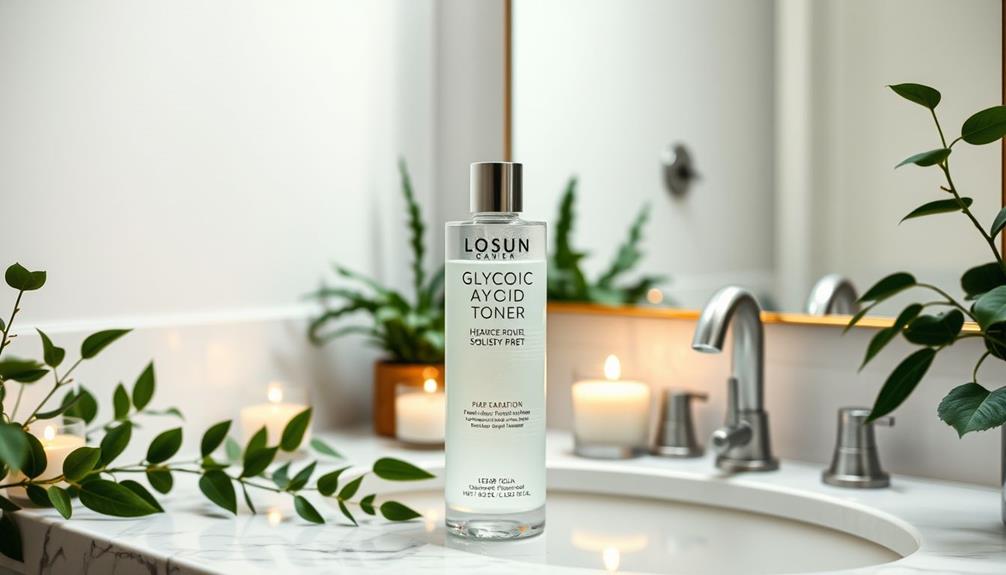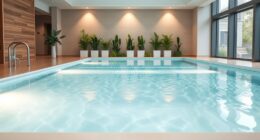Glycolic acid is an excellent solution for combating acne and revitalizing your skin. This potent alpha hydroxy acid helps exfoliate dead skin cells, preventing blocked pores and reducing redness. By using it regularly, you can achieve a more radiant complexion with fewer imperfections. It is generally safe at lower concentrations, but it is advisable to start slowly, particularly if you have sensitive skin. Using a moisturizer in addition can help keep your skin hydrated. There are a variety of products available, such as cleansers and peels, tailored to suit your specific needs. Stay tuned to learn more tips and suggestions on effectively integrating glycolic acid into your skincare regimen.
Key Takeaways
- Glycolic acid, an alpha hydroxy acid, effectively exfoliates dead skin cells, helping to prevent clogged pores and reduce acne lesions.
- Regular use promotes cell turnover and improves skin texture, leading to a brighter, more even complexion and diminished post-acne scars.
- It exhibits antibacterial properties, targeting acne-causing bacteria and minimizing inflammation associated with breakouts.
- Recommended concentrations for beginners range from 5% to 10%; gradual introduction is essential to avoid irritation.
What Is Glycolic Acid?

Glycolic acid is a potent alpha hydroxy acid derived from sugarcane that effectively exfoliates your skin by breaking down the bonds between dead skin cells. This action promotes cell turnover, allowing fresher and smoother skin to surface.
Its strong exfoliating properties make glycolic acid a popular choice in many skincare products designed for acne treatment. Notably, incorporating essential oils into your skincare routine can also provide benefits for overall skin health, such as natural alternatives to chemical products.
When you incorporate glycolic acid into your routine, you're not just sloughing off dead skin; you're also minimizing pore clogging, which can lead to breakouts.
Clinical studies have shown that regular use of glycolic acid can greatly improve acne severity and overall skin texture. It's available in various formulations, including cleansers, toners, and peels, with concentrations ranging from 5% to 30%.
If you're new to glycolic acid, starting with a lower concentration is wise to minimize irritation while still reaping the benefits of this powerful AHA.
How Glycolic Acid Works

Understanding how glycolic acid works reveals its effectiveness in treating acne through its powerful exfoliation and skin-rejuvenating properties.
This alpha hydroxy acid (AHA) gently exfoliates the outer layer of dead skin cells, promoting cell turnover and preventing clogged pores—one of the leading contributors to acne. By removing these dead skin cells, glycolic acid helps to reveal fresher, healthier skin beneath, reducing the likelihood of breakouts.
Additionally, incorporating a consistent skincare routine, including products like skincare patches, can also enhance skin health and improve results skincare patches.
In addition to its exfoliating action, glycolic acid enhances moisture retention in your skin barrier. This helps keep your skin hydrated while simultaneously reducing excess oil production, which can also lead to acne.
Moreover, its antibacterial properties help combat acne-causing bacteria on the skin's surface, tackling the problem from multiple angles.
Studies show that regular use of glycolic acid can greatly reduce the severity of acne lesions, making it a great option for those with mild to moderate acne.
Over time, you can also expect improvements in skin texture and tone, assisting in the reduction of acne scars and post-inflammatory hyperpigmentation.
With consistent use, glycolic acid can be a game-changer in your acne-fighting regimen.
Benefits for Acne Treatment
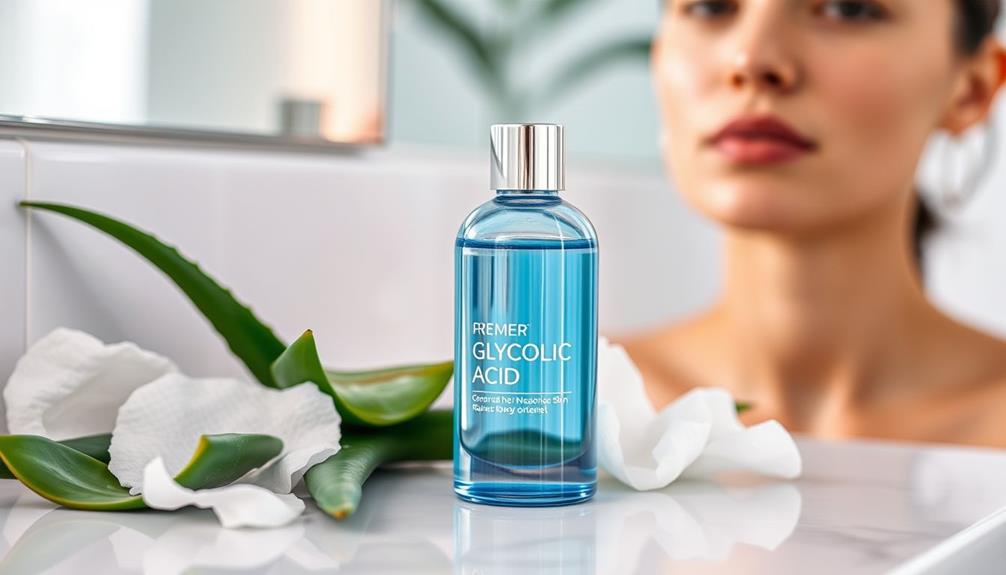
When you use glycolic acid, you're actively promoting exfoliation and cell renewal, which can help keep your pores clear and reduce acne.
Additionally, incorporating essential oils for skin benefits can enhance your skincare routine and further support acne treatment.
This treatment not only targets existing breakouts but also minimizes inflammation, leading to fewer flare-ups.
Plus, the brighter, more even complexion you achieve can boost your confidence as you tackle acne head-on.
Exfoliation and Cell Renewal
Exfoliation through glycolic acid effectively unclogs pores and reduces acne lesions by sloughing off dead skin cells. This powerful ingredient exfoliates the surface of your skin, promoting cell turnover, which is vital for maintaining a clear complexion.
When you incorporate glycolic acid into your skincare routine, you're helping your skin shed old, dull cells more rapidly. This rapid shedding minimizes the chances of clogged pores, a common culprit behind acne breakouts. Additionally, practicing mindfulness techniques, such as those found in yoga for back pain relief, can help manage stress, which is often linked to acne flare-ups.
Studies have shown that consistent use of glycolic acid can lead to a significant reduction in the severity and frequency of acne, particularly for mild to moderate cases. Furthermore, its ability to enhance moisture retention in the skin barrier helps prevent excessive dryness, a factor that can worsen acne symptoms.
By maintaining a balanced skin barrier, you not only alleviate dryness but also create an environment less conducive to acne-causing bacteria.
In essence, glycolic acid offers a dual benefit: it exfoliates to clear pores and promotes cell renewal, making it a valuable ally in your fight against acne. With regular use, you'll likely notice smoother, clearer skin over time.
Reducing Inflammation and Breakouts
Glycolic acid not only promotes cell renewal but also plays a key role in reducing inflammation and the frequency of breakouts associated with acne. By exfoliating dead skin cells, glycolic acid helps to unclog pores, which is essential for preventing the formation of new acne lesions. Regular use can noticeably improve the severity of your acne, leading to fewer blemishes over time.
Additionally, maintaining good mental health is critical, as stress can exacerbate skin issues, including acne, making it important to incorporate stress-reducing techniques into your routine for overall well-being and skin health mental health screenings in older adults.
Moreover, glycolic acid enhances skin texture and minimizes post-acne scars, making it a valuable addition to your skincare routine. Its antibacterial properties also target acne-causing bacteria, further aiding in reducing inflammation and preventing breakouts. When you incorporate glycolic acid into your regimen, you're not just treating current acne; you're proactively working to avoid future outbreaks.
For those with mild to moderate acne, dermatologists often recommend glycolic acid due to its proven effectiveness. You'll notice that it helps in maintaining a clearer complexion while promoting overall skin health. So, if you're struggling with acne, consider glycolic acid as a powerful ally in your journey to clearer skin.
Safety and Side Effects
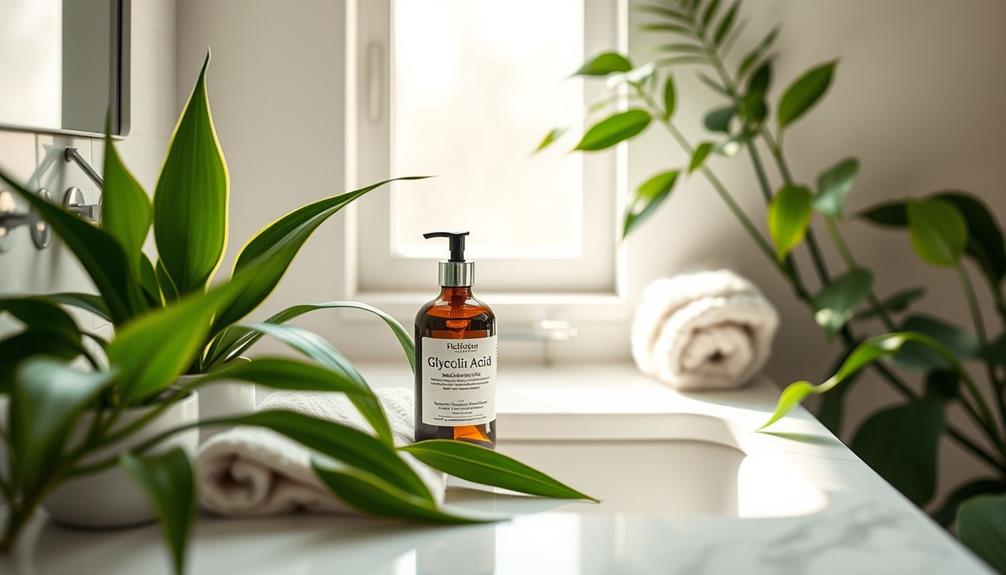
Using glycolic acid can be safe for most people, especially in lower concentrations, but it's crucial to be aware of potential side effects.
While concentrations of 10% or less are generally safe, higher levels should only be used under dermatologist supervision to avoid serious reactions.
Common side effects include skin irritation, redness, and a burning sensation, particularly if you have sensitive skin.
Additionally, awareness of common errors in skincare routines can enhance personal growth and learning in achieving clear skin, as effective treatment often requires a nuanced approach small mistakes in skincare.
Increased sun sensitivity is another notable risk associated with glycolic acid for acne, so daily sunscreen application is a must to protect your skin from further damage.
If you have darker skin tones, be cautious, as glycolic acid can lead to post-inflammatory hyperpigmentation or the development of new dark spots.
Before starting glycolic acid treatment, especially if you have severe acne or have previously used prescription medications, consulting with a dermatologist is highly recommended.
They can help assess your skin type and guide you on the safest way to incorporate glycolic acid into your routine.
Ultimately, being informed about the safety and potential side effects will help you achieve the best results while minimizing risks.
Application Guidelines
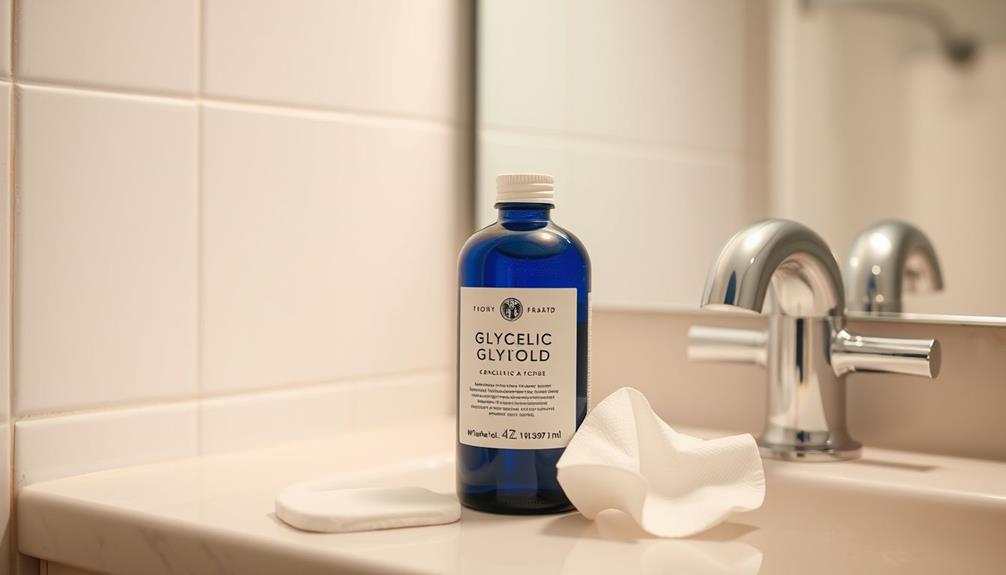
For ideal acne treatment, apply glycolic acid in concentrations of 10%-15%, starting once daily and increasing to twice daily as your skin builds tolerance.
It's essential to begin with lower concentrations, especially if you have sensitive or acne-prone skin. This gradual approach minimizes irritation and helps your skin adjust to the active ingredient.
When using glycolic acid, consistency is key. Aim to incorporate it into your daily skincare routine for up to four months to experience the best results. Regular application can enhance exfoliation, which leads to clearer skin and a reduction in acne lesions over time.
After applying glycolic acid, remember to follow up with a broad-spectrum sunscreen during the day. This step is significant as glycolic acid can increase your skin's sensitivity to the sun, making it more susceptible to damage.
If you're dealing with severe acne, consult a dermatologist who may recommend professional glycolic acid peels. These treatments use higher concentrations and are performed under supervision to guarantee safety and effectiveness.
Clinical Research Findings

Recent clinical research highlights the effectiveness of glycolic acid in treating acne and improving skin texture through various formulations and treatments.
In a study published in the *Journal of Cosmetic Dermatology*, glycolic acid peels greatly improved acne scars and overall skin texture, particularly when combined with microneedling.
Additionally, research in the *Chin Medical Journal* found that a topical formulation containing 5% glycolic acid effectively reduced acne lesions in individuals with mild to moderate acne vulgaris.
A randomized trial demonstrated that regimens using 70% glycolic acid peels resulted in remarkable improvements in photodamaged skin, underlining its efficacy in acne treatment.
Furthermore, findings from the *Journal of the American Academy of Dermatology* indicated that consistent use of glycolic acid products led to a considerable decrease in inflammatory acne lesions over time.
These clinical trials show that glycolic acid's exfoliating properties not only help prevent new acne breakouts but also diminish the appearance of existing acne scars.
With such promising results, incorporating glycolic acid into your skincare routine could be a game-changer for achieving clearer, smoother skin.
Recommended Products

What products can help you effectively incorporate glycolic acid into your skincare routine for acne?
Start with Luxinys' Glycolic Acid Face Wash and Toner. These products are designed to exfoliate dead skin cells, reduce the appearance of fine lines, and promote a clearer complexion specifically for acne-prone skin.
Another great option is Dermatologists Choice Glycolic Peel Cleansing Pads, which have shown effectiveness in reducing acne lesions and improving overall skin texture with regular use.
If you're shopping at Target, you'll find a wide selection of products containing glycolic acid formulated for various skin tones, ensuring you have options that cater to your specific skin concerns.
Many of these products come in concentrations of 10%-15%, which are excellent for daily use to achieve ideal results without irritation.
For enhanced effectiveness in treating acne vulgaris, consider products that combine glycolic acid with other beneficial ingredients like salicylic acid.
This combination can help prevent breakouts while delivering the exfoliating benefits you need.
With these recommended products, you're well on your way to clearer, healthier skin.
Tips for Effective Use

To get the best results from glycolic acid, start with a low concentration of about 5-10% to help your skin adjust.
Consistent application is key, so make sure you incorporate it into your nightly routine after cleansing.
As your skin builds tolerance, you can consider increasing the concentration for enhanced benefits.
Start Low Concentration
Starting with glycolic acid at low concentrations, around 5% or less, can greatly reduce the risk of skin irritation, especially for those with sensitive skin.
By starting low concentration, you allow your skin to acclimate to the exfoliating effects without overwhelming it.
When using glycolic acid, it's vital to pay attention to how your specific skin type reacts. Some may experience mild tingling, which is normal, but if irritation occurs, you should stop use and consult medical advice.
As you monitor your skin's response, consider gradually increasing the concentration or frequency of use based on your skin's tolerance. This approach helps prevent adverse reactions while optimizing the benefits of glycolic acid for acne management.
Before applying a new product, patch testing on a small area of skin can be a smart move to identify any potential reactions.
Consistent Application Essential
Consistent application of glycolic acid is key to releasing its full potential in treating acne effectively. For best results, aim to use glycolic acid products once or twice daily.
You'll often notice improvements in your skin within about four months of regular use. Start with a lower concentration, ideally up to 10%, to reduce the risk of irritation, and gradually increase it as your skin gets used to the treatment.
Incorporate glycolic acid into your routine after a gentle cleansing step to clear away impurities without aggravating your acne-prone skin.
To enhance the efficacy of glycolic acid, always follow up with a moisturizer. This helps maintain hydration and prevents dryness, which can worsen acne symptoms.
Frequently Asked Questions
Is It Good to Use Glycolic Acid on Acne?
Yes, using glycolic acid on acne can be beneficial. It exfoliates dead skin cells, unclogs pores, and promotes cell turnover, which helps reduce acne lesions and improve overall skin texture. Just be sure to use it regularly.
How Long Does It Take for Glycolic Acid to Clear Acne?
Isn't it ironic? You expect quick fixes, yet glycolic acid typically takes 4 to 6 weeks to show results. Stick with it, though; in 8 to 12 weeks, you'll likely see significant improvements.
Can I Use 7% Glycolic Acid Every Day?
You can use 7% glycolic acid daily, but start slowly to avoid irritation. Gradually increase usage as your skin adapts. Don't forget to apply sunscreen daily, as it can make your skin more sensitive.
Does Glycolic Acid Get Rid of Hormonal Acne?
Yes, glycolic acid can help reduce hormonal acne. It exfoliates dead skin cells, unclogs pores, and decreases inflammation, leading to clearer skin. Regular use may improve overall acne severity and skin texture.
Conclusion
Incorporating glycolic acid into your skincare routine could be a game changer for managing acne.
Its ability to exfoliate and promote cell turnover helps keep breakouts at bay while improving your skin's texture.
So, why not give it a try and see the difference for yourself?
Remember to follow application guidelines and choose the right products for your skin type.
With a little patience and consistency, you might just uncover the clearer, healthier skin you've been longing for!

